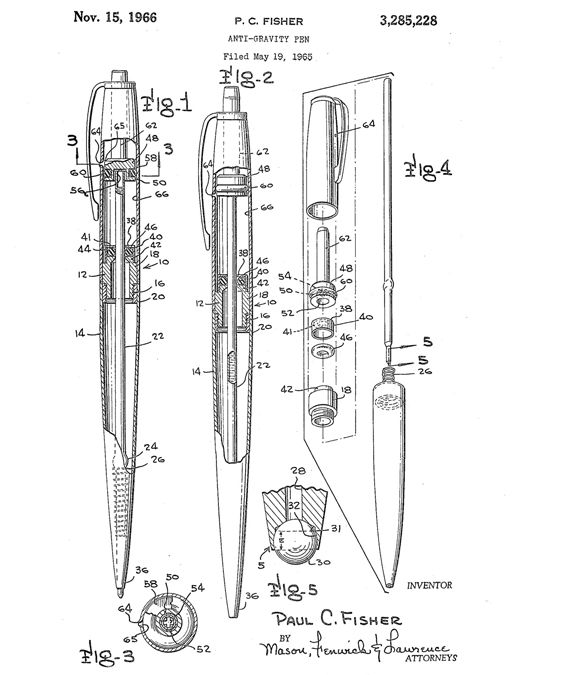The Fisher Space Pen Boldly Writes Where No Man Has Written Before
The Fisher Space Pen has been made famous by Apollo astronauts and Jerry Seinfeld. But just how does it work? And is NASA really spend millions making it?
![]()

The Fisher Space Pen, Model AG7 (image: Fisher Space Pen Co.)
Recently on Design Decoded, we looked at President Obama’s favorite technologically advanced pen and today we’re looking at mine. During my last visit to the Smithsonian National Air and Space Museum, there were two things I had to do: see the original 1903 Wright Flyer and buy a Fisher Space Pen. I couldn’t help but wonder though, just who was this “Fisher” and what makes the Space Pen so space-y?
The Fisher Space Pen was created by inventor, pen manufacturer, and (brief) JFK political opponent Paul C. Fisher. Fisher had been an innovator in the pen industry for years, even before he started his own company. His mastery of the ballpoint pen can be attributed in part to his experience working with ball bearings in a airplane propeller factory during World War II. Fisher also invented the “universal refill” ink cartridge, ultimately leading him to create the very first “Anti-Gravity” pen, the AG7, which was patented in 1966 and famously used by astronauts during the Apollo space missions. However, it’s a popular misconception that NASA invested millions of dollars into the development of the zero-gravity writing instrument. They didn’t. Nor did the space agency approach Fisher to develop a pen for use by American astronauts. According to a 2006 piece in Scientific American, the truth is that Fisher had been working on the design for years and had invested $1 million into the pen’s development. But Fisher wasn’t dreaming of astronauts writing postcards from Earth orbit, he was just looking to make a good pen that worked without leaking. After years of research and prototypes, he created what he believed to be the perfect pen – a pen with ink that wasn’t exposed to air and didn’t rely on gravity so it wouldn’t leak or dry up; a pen that could write underwater and function at temperatures ranging from -30 to 250 degrees Fahrenheit. Fisher’s breakthrough was perfectly timed with the space race and he offered the pens to NASA for consideration. After two years of testing, it was approved and Fisher’s pen accompanied Apollo 7 astronauts into space.
However, Fisher seems to enjoy perpetuating the NASA myth a little himself. In a 2004 interview, he claimed that the design came to him in a dream after NASA approached him in 1965 with their problem:
About two nights I had an interesting dream. My father had died about two years before, and in that dream, he came to me and said Paul, if you add a minute amount of rosin to the ink, that will stop the oozing. I told the chemist about that, and the chemist laughed! He said that won’t work. He tried every type and quantity of rosin. Three months later he came back to me and he said I was right! He said he was trying to find a way to make rosin work, but then he realized that I meant resin! He used two percent resin, and it worked fine….I called NASA and told them we could do it, and we developed the most valuable patent in all of the pen industry.
In the end, Fisher sold NASA 400 pens for the Apollo program for a 40 percent discount but, perhaps more importantly, he got some amazing marketing from the deal. Who wouldn’t want to write with the pen used by some of the first men in space? Early advertisements for the pen claimed it could write for 100 years (“even upside down!”). Contemporary product literature uses a very different but no less impressive metric, claiming that the newest space pens can write for 30.7 miles. Either way, it lasts longer and is much more reliable than standard ballpoint pens.
But did we even need a space pen in the first place? It’s said that Russia’s answer to the same problem was the pencil, bringing to mind the old Russian saying: “better is the enemy of good enough.” But wood and lead shavings in a zero-gravity, oxygen-rich environment can be incredibly dangerous, liable to interfere with instruments or catch on fire. Soon after its proven use by the Apollo crews, cosmonauts also started carrying the Fisher Space Pen in their space pocket-protectors.

Patent #3,285,228, The Fisher Anti-Gravity Pen (image: Google patents)
The secret to the space pen is in the cartridge. It is a hermetically sealed tube containing thixotropic ink, pressurized nitrogen gas, and a tungsten carbide ballpoint tip. During development, Fisher found that while the pressurized cartridge successfully pushed ink out the tip of the pen, it also successfully leaked uncontrollably. Rather than redesign the cartridge, Fisher redesigned the ink. He developed a thixotropic ink that is a gel at rest, but turns into a liquid under pressure. Sort of like toothpaste. With this new, thicker ink, the pen didn’t leak and would only write when pressure was applied to the ballpoint. Success.
Paul C. Fisher died in 2006 but the legacy of his Space Pen continues. In 1998, “Seinfeld” famously built an episode around the pen (TAKE THE PEN!) and that same year, the QVC shopping channel showed the pen in use on the Space Station Mir, making it the first product sold from space. Today, there are nearly as many space pens as there are stars in the sky. Actually, that doesn’t quite hold up, but there are a lot of different space pen models, hundreds of different designs, and multiple engraving options. One thing that hasn’t changed, however, is the groundbreaking –or perhaps I should say atmosphere-breaking– ink cartridge that makes the pen possible.
/https://tf-cmsv2-smithsonianmag-media.s3.amazonaws.com/accounts/headshot/Jimmy-Stamp-240.jpg)
/https://tf-cmsv2-smithsonianmag-media.s3.amazonaws.com/accounts/headshot/Jimmy-Stamp-240.jpg)